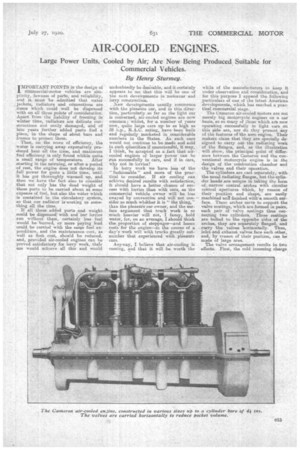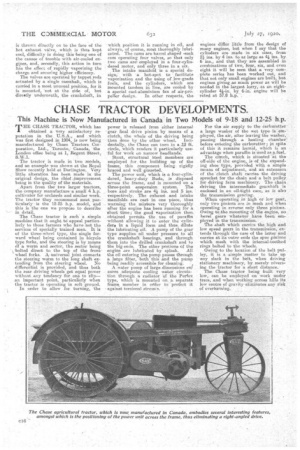AIR-COOLED ENGINES.
Page 13

Page 14

If you've noticed an error in this article please click here to report it so we can fix it.
Large Power Units, Cooled by Air, Are Now Being Produced. Suitable for Commercial Vehicles,
By Henry Stunney.
IMPORTANT POINTS in the design of
Chnimercial-motor vehicles are simplicity, fewness of parts, and reliability, and it must be admitted that water jackets, radiators and ccirmections are items which could well be dispensed with on all three points of consideration. Apart from the liability of freezing in time, radiators are delicate constructions and easily damaged, and -of late years further added parts find a place, in the shape of ..stiout bars and frames to protect them.
Then, on the score of efficiency, the water is carrying away expensively produced heat all the time, and maximum fuel efficiency is only found within quite a small range of temperature. After starting in the morning, or after a period of rest, the engine does not develop its full power far quite a little time, until it has got thoroughly warmed up, and then we have the fact also to consider that not only has the dead weight of these parts to be carried about at some expense of fuel, bat also the water which is contained in the circulatory system, so that our radiator is costing us something all the time.
If all these added parts and weight could be dispensedwith and our lorries run without them, certainly less fuel would be burned, or more paying load could be carried with the same fuel expenditure, and the maintenance cost, as well as first cost, should he reduced, and, provided air-cooled engines can be proved satisfactory for lorry work, their use would achieve all this and would
undoubtedly be desirable, and it certainly appears to me that this will be one of the next developments in motorcar and lorry construction.
New developments usually commence. with the pleasure Car, -and in this direction, particularly so far as the light car is concerned, air-cooled engines are liow common; whilst, for a number of years now, quite large cars up to as high as R.A.G. rating, have been built and regularly marketed in considerable numbers in the States. As such ears would not continue to be made and sold in such (identities if iinsuceessful, at may, I think, be accepted as a ;fact that aircceied engines of larger power can be ru.n successfully in cars, and if in cars, why not in lorries?
In lorry work we have, leas of the " fashionable " and more of the practioal to consider. If air cooling can achieve desired results with satisfaction, it should have a hatter chance of success with lorries than with cars, as the commercial vehicle owner will be loss swayed by convention and will not consider so much whether it is " the thing,'' than the pleasure car owner, and the surface argument that truck work is so much heavier will not, I fancy, hold water, for, on an average, I should think the., pro.portion of stoppages—and hence rests for the engine—an the course of a day's work will with trucks greatly outnumber that experienced with pleasure cars.
Anyway, I believe that air-coolingis coming, and that it will be worth the
while of the manufacturers to keep it under observation and consideration, and for this purpose I append the following .particulars of one of the latest American developments, which has reached a practical commercial stage.
The Cameron air-cooled motors are not merely big motercycle engines on a car basis, as so many of those which arv3 now operating successfully in light cars on this side are, nor do they present any of the features of the aero engine. Their makers claim that they are specially designed to carry out the radiating work of the flanges and, as the illustration will show, the principal point of difference between the Cameron and the 'conventional motorcycle engine is in the design of the combustion chamber and the valves. and their operation.
The cylinders are cast separately, with. the usual radiating flanges, but the cylinder heads are unique in taking the form of narrow central arches with circular' central apertures which, by reason of their position and shape, are easily
— machined an finished with's smooth surface. These arches serve to support the valve seatings, which are formed in pairs, each pair of valve seatings thus connecting two cylinders. These seatings are bolted to the opposite sides of the arches, they are separately flanged, and carry the valves horizontally. Thus, inlet and exhaust valves face each other, and, by reason of their position, can be made of large area. The valve arrangement results in two effects. First, the cold incoming charge
is thrown directly on to the face of the hot exhaust valve, which is thus kept cool, difficulty in doing this being one of the causes of trouble with air-cooled engilies, and, secondly, this action in turn has the effect of rapidly vaporizing the charge and securing higher efficiency.
The valves are operated by tappet rods actuated by a single camshaft, which is carried in a most unusual position, for it is mounted, not at the side of, but direttly underneath, the crankshaft, in
which position it is running in oil, and always, of course, most thoroughly lubricated. The cams are barrel shaped'each cans operating four valves, so that only two cams are, employed in a four-eylindereii motor, and only three in a six. The intake manifold is a special design, with a hot-spot to facilitate vaporization and the using or low-grade fuels, and the cylinders, which are mounted tandem in line, are cooled by a special cast-aluminium fan of air-pro
peller design. In other respects, the engines differ little from the design of many engines, but when I say that the cylinders are made in six sizes, from
ins. by 4 ins, to as large as 41, Ms. by 6 ins., and that they are aesembled in. combinations of two, four, six, and even eight it will be seen that a very corn-, .plete series has been worked 'out, and that not only small engines are built, but engines giving as much power as will be i needed n the largest lorry, as an eightcylinder 44-in. by 6-in, engine will be rated at 57.8 h.p. '•




























